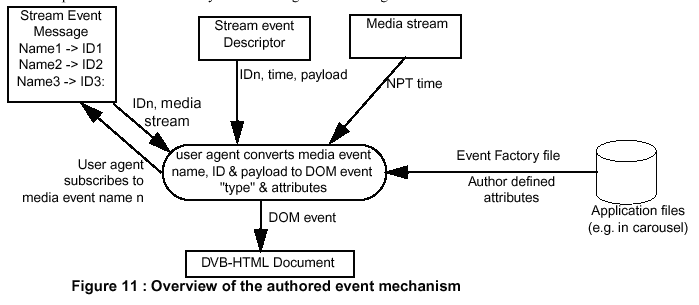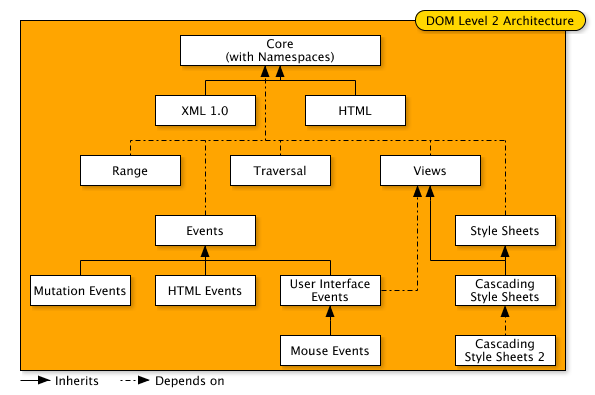Contents
- Abstract
- Introduction
- An overview of the main points of the MHP standard
- Compatibility with the Internet
- Opportunities for convergence of content
- Conclusion
- About the Author
- Request for Comments
Abstract
Australian free-to-air broadcasters have recently adopted the European Multimedia Home Platform (MHP) as the Australian standard for interactive TV. MHP is based on Internet and web standards and so offers compatibility and convergence between TV and the Internet. Nevertheless, MHP is a complex standard of more than 1440 pages. An overview of the main points of the standard, and its compatibility with the Internet and opportunities for convergence of content are discussed.
Introduction
DVB-HTML... One application area considered of commercial importance for the Multimedia Home Platform (MHP)is that of the provision of a hypertext or "super teletext" system for the presentation of information alongside broadcast. In order to promote interoperability, both between different MHP vendors and where possible with the wider internet, this document describes a specific subset of the data formats needed for use in the World Wide Web adopted by the MHP, plus DVB specific extensions.From: Digital Video Broadcasting (DVB); Multimedia Home Platform (MHP), Specification 1.1 (ETSI 2000).
What is the Multimedia Home Platform (MHP)?
The Multimedia Home Platform (MHP) attempts to adapt existing Internet and web standards for to digital Television (DTV). The aim is to provide interactive digital content that can be viewed on set top boxes and multimedia PCs. MHP is intended to operate with satellite, cable, terrestrial and microwave systems.
June 28, 2001 First MHP applications for digital TV
First MHP applications for digital TV The first MHP (Multimedia Home Platform) applications for digital TV are now available. Watch a streaming video demonstrating the use of a browser in digital TV. The video was made by recording the video output of a MHP capable set-top-box.
From: Sonera Plaza MediaLab 2001
Who produced it?
MHP was produced by the Digital Video Broadcasting Project (DVB), a European-based consortium of broadcast companies and regulatory bodies. DVB Standards are published by the European Telecommunications Standards Institute (ETSI).
Where can I get the standard?
The current standard is listed on the DVB web site as: "Digitsl Video Broadcasting (DVB) Multimedia Home Platform (MHP) TS 101 812 A057 (05/00)" (note the misspelling of "Digital" as "Digitsl").
A copy of the current draft (1448 pages) is available as a 19 Mbyte zipped PDF document on the MHP web site. The standard is difficult to use, due to it being published as one large PDF file. The use of PDF, is at odds with the stated aim of the standard to use Internet and web standards. Reading the standard is a cumbersome process and lowers its credibility as a guide to efficient electronic communication. This contrasts with successful Internet and web standards, available in Internet and web formats which are simple and quick to download, translate or copy. This, and the poor quality of the design of the MHP web site, may prove a major impediment to use of the standard.
Work is underway to have MHP adopted in Australia, under the formal Standards Australia processes:
Committee CT/2 Broadcasting and Related Services has approved the following drafts for publication: ...
Supplement 2 to AS 4599—1999 Digital television - Terrestrial broadcasting – Characteristics of digital terrestrial television transmissions
This Supplement to AS 4599—1999 specifies additional elements of the digital terrestrial television system to be used in Australia and addresses amendments to Service Information, the Standard for implementation of Data Bbroadcasting, Implementation of the logical-channel-descriptor and the Multimedia Home Platform...
Committee CT/2/4: Television Transmitting Equipment
From: TAS: In the pipeline, Standards Australia, May 2001
Chairman: Roger Bunch, FACTS (Federation of Australian Commercial Television Stations)
Projects Manager: Bala Balakrishnan (Sydney)
What will MHP be used for?
Typical uses intended for MHP are:
- EPG: Electronic Programme Guides,
- Super teletext: for information services such as news and financial information,
- Video synchronised content: for TV game shows and sports information,
- Security: for e-commerce and control of access to TV content.
How is an MHP Set-Top Box Built?
Existing standards are used for content including PNG, JPEG (still images), MPEG-2 (Video/Audio), DVB-HTML (text/web pages). MHP is a virtual machine (DVB-J) based on the Java Virtual Machine specification from Sun Microsystems, with standardised interfaces (APIs) to MHP specific functions.
Institut für Rundfunktechnik (IRT), have produced a partial MHP Reference Implementation (IRT’s MHP-RI) available to the MHP community. However, this is not planned to implement MHP until March 2002 fully. The MHP-RI is implemented in Java to run under Windows NT 4.0 on at least the equivalent of a 500-MHz Pentium III and 32 to 128 Mbytes of RAM.
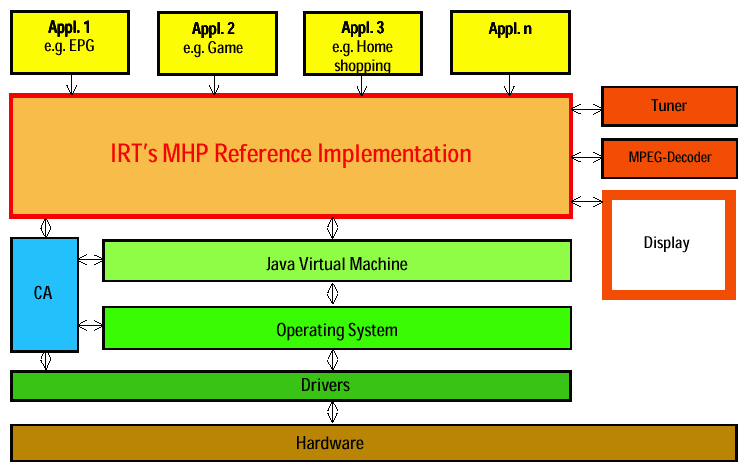
Diagram from: MHP Reference Implementation, Institut für Rundfunktechnik (IRT), 2001
Linux based, free open source software for MHP has also been proposed:
Alas, when Digital television started in Europe, some companies like OpenTV, Beta Research or Canal+ tried to put a proprietary software layer on top of the open DVB standards. The first Set-Top Boxes on the market were therefore incompatible - electronic programme guides produced for the German market could not be used with French Set-Top boxes and vice versa.
As many of us have suspected, no one manufacturer is big enough to impose a proprietary standard on a European or worldwide market. The open standard for content representation on digital television is called MHP (Multimedia Home Platform). MHP is nearly finished by the DVB members and will be an open (ETSI) standard soon. However, MHP is heavily based on JAVA which is under the control of SUN. The openness of MHP therefore largely depends on the openness of JAVA. From: Linux TV The standard for the digital world, linuxtv.org, 2001
The TiVo digital video recorder is an existing Linux based TV device. The potential of such devices to be expanded, was demonstrated in Hacking the TiVo by Andrew Tridgell at Linux.conf.au 2001:
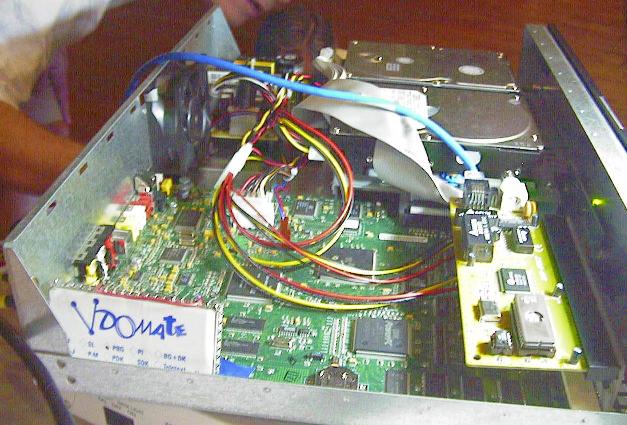
I got truly amazed when I found out that Tridge and friends, not satisfied with adding more hard drive space, soldering memory on the motherboard, reverse engineering the proprietary connector on the motherboard and turning it into an ISA bus, turning a Tivo entirely into a PAL capable device, they reversed engineered the video format, got video from the Tivo to play over the network on outside computers, figured out the TV guide database format and wrote programs to make their own database feeding for Australia through information automatically gathered by scripts on a web TV guide. I mean these people created a new Tivo product from the existing one before Tivo, and with no technical help or docs from Tivo whatesoever.From: Inside Tivo, Marc Merlin, 2001
The MHP specification envisions three modes of use (profiles):
- An enhanced broadcasting profile: for broadcast (one way) services,
- An interactive broadcasting profile: interactive (two way) services,
- An Internet Access Profile: Internet based, or Internet-like service.
MHP is a broad standard and further details will need to be put in place to produce a workable system. If these details are not standardised, or at least harmonized, content produced for one MHP system will not necessarily be playable on another:
Information is reproduced with the permission of OpenTV from a “White Paper” published at IBC 2000... While MHP provides universal interoperability, it is not in and of itself a complete interactive solution. To achieve this degree of interoperability, MHP does not attempt to specify hardware or conditional access interfaces or other implementation-specific details. Also, since the current generation of set-top boxes does not meet MHP’s hardware requirements, a migration path is required that will allow continued interactivity with the currently deployed set-top boxes until it is economically feasible to replace them with MHP-compatible devices. ... OpenTV and Matsushita are cooperating to provide an MHP solution. This solution will be commercially available in December 2001.
Report on API Migration, Appendix 3, DigiTAG, May 2001
An extensive set of presentation notes available on-line from the Dotcom Workshop (October 2000), give an overview of MHP:
Main topics:
... Download the presentation material ..., Dotcom Workshop - 24 - 25 October 2000 at IRT / Munich, MHP Forum.de 2000.
- Linking broadcast & IT world (dotcom world)
- Creating content for MHP
- Developing MHP applications and the tools required
- Setting up a MHP community
An overview of the main points of the MHP standard
MHP attempts to merge European DVB standards with those of the Internet. Much of the bulk of the standard comes in merging the two and reconciling the needs of broadcast and interactive modes of operating. It is not clear what applications will prove most popular with MHP. It might have been better if the standard had been developed as a set of documents, building up functionality, based on experience, rather than as one "big bang". The Internet has shown the benefits of incremental standards development.
Transport Protocols
MHP envisages transport of data through a broadcast stream and/or an interaction channel. Normally the broadcast stream would provide the bulk of the content using Broadcast Channel Protocols, as defined in DVB standards (particularly EN 301 192 1.2.1 Specification for Data Broadcast) transmitted as conventional TV. The interaction channel would be a dial-up, wireless, or cable TV carried Internet Protocol (IP) transmission. One option is a hybrid between broadcast and interaction transmission where directory information is provided in the broadcast stream but content via the interaction channel. It is not clear if the standard can support, or would be useful for, a purely Internet-based service.
Content formats
Static formats
- Bitmap image formats (JPEG, PNG, GIF, MPEG-2 I-Frames): Commonly used image formats are supported. However, the standard takes the dangerous approach of requiring any pixel scaling, colour space or gamma settings in an image file to be ignored. This could result in distortion of some images and may be illegal under moral rights provisions of copyright law.
- MPEG-2 Video "drips": The drip feed mode allows an application progressively to feed the MPEG-2 video decoder with chunks of an MPEG-2 video stream. This appears an unnecessary and complex addition to the standard.
- MPEG-1 Audio: The format for audio clips.
- Text:MHP devices are required to display and accept the character set commonly used for European languages. It could be assumed that devices for worldwide use can use Unicode, to support other languages, but this is not required by the standard.
Broadcast streaming formats
- MPEG Audio: As for the static format.
- MPEG Video: 25 Hz MPEG-2 video is specified.
- Subtitles: DVB Subtitles and Teletext formats are both provided for subtitles, with the DVB Subtitles taking precedence when both are provided. Java applications can detect and control subtitles, but programme access to Teletext data packets is not permitted. This is presumably to try to prevent unauthorized use of Teletext content. However, it may prevent useful services, such as searching and indexing multimedia content based on the text of subtitles. MHP supports Teletext for subtitles, not as an alternative to web-style content. Implementers are free to implement full Teletext outside MHP.
Resident fonts
The only built-in font required is the Sans Serif "Tiresias", plain (no italics or bold), in four sizes:
- Heading: 36 points (24 TV lines)
- Subtitle: 31 points (21 TV lines)
- Body: 26 points (18 TV lines)
- Footnote: 24 points
MHP devices are only required to support text orientation as used for European languages (that is horizontal left to right, top to bottom). Note that the default ("body") font size of 26 points is approximately the same as 18 TV lines. While these font sizes are suitable for TV display they are much larger than fonts used in web computer applications.
Colour Representation
MHP uses an RGB colour space. A detailed mathematical explanation is provided in the standard, but while important for TV applications this appears excessive for a web application.
Hypertext
MHP devotes 110 pages of the standard to hypertext or "super teletext" based on web standards. The section is misleadingly entitled "DVB-HTML", when it is XHTML plus a set of style and scripting standards (CSS, DOM and ECMAScript). DVB-HTML is not required if only the Enhanced Broadcast Profile of MHP is implemented and is described as having a supplementary role "alongside broadcast". However, it is difficult to envisage practical applications which do not use DVB-HTML.
The MHP specification provides for integration of DVB-HTML applications, with: signalling, transportation and content. MHP's DVB-HTML is described as a subset of World Wide Web standards, but as with WAP (discussed later) may be inconsistent with the current direction of web development. Not all formally adopted World Wide Web standards are necessarily taken up by the Internet community and not all features are well supported.
DVB-HTML
DVB-HTML is a XHTML implementation using European characters and the Document Type Description (DTD) at "http://www.dvb.org/mhp/dtd/dvbhtml-1-0.dtd".
Web browsers traditionally attempt to display web pages which do not fully conform to HTML standards, by ignoring unsupported features. MHP attempts to formalize this behaviour with rules to support "Invalid but conformant documents". However, the application of these rules is unclear to this author.
DVB-HTML uses XHTML modules: Structure, Text, Hypertext, List, Presentation, Bi-directional Text, Forms, Basic Tables, Image, Client side Image map, Object, Frames, Target, Iframe, DVB Intrinsic events, Metainformation Module, Scripting, Style sheet, Style Attribute, Link and Base
Omitted: Applet, Edit, Basic Forms, Server side image map, Intrinsic events, Name Identification and Legacy.
The strict use of XHTML would limit the use of some legacy HTML features. One explicitly mentioned in the standard is that the id attribute has replaced the name attribute in specifying a target frame. The result could be that links to target frames will not work, if they use the name attribute.
The alternate text for disabled users is supported. An obvious way to implement this would be with text displayed over, or in place of an image. A talking browser could read text to a blind user, but the details are implementation dependent.
The accesskey attribute of HTML 4 is implemented. This could be important to TV devices as it allows hypertext to be navigated with a few keys on a TV remote control.
Implementations are not required to provide a scrolling mechanism for frames. However it is likely any practical implementation will need to do so.
A major limitation of the MHP standard is that it does not define referencing of video segments of finite duration. MHP is not a true multimedia format, in the style of the Synchronized Multimedia Integration Language (SMIL). It provides triggers (discussed below) for synchronization.
Synchronization
MHP provides "triggers": small messages with a time code and action sent in a broadcast, which can start a particular video, audio or action. The synchronization features are similar to SMIL and it is not clear why the SMIL module of XHTML was not used.
From: Digital Video Broadcasting (DVB); Multimedia Home Platform (MHP), Specification 1.1 (ETSI 2000).
Cascading Style Sheets
CSS Cascading Style Sheets (CSS2) are provided for specifying the look of XHTML content. There are some minor limitations, such as support for an aural style sheet is not required. The immaturity of CSS implementations and lack of use is likely to be more of a problem for implementations than limits to the standard. Also current implementations for conventional (static) web pages appear to take a perceptible time to render a CSS controlled page and so performance with video may be a problem.
A dvb-tv media type is defined for TV-type devices with small screens. Some additional properties suiting TVs are:
- Opacity: Allows object to be rendered semi-transparent (as used to place semi-transparent text over a video image).
- Clip-video: Allows an arbitrary portion of a video image to be displayed.
- Focus traversal and short-cuts: Defines the order of navigation of elements using the navigation keys, and short cut keys.
- Viewports: The MHP standard includes a detailed, but unclear, description of how coordinate space used to define a video window on the screen. The resulting complexity appears due to a difference in terminology used in DVB and CSS standards.
Scripting
MHP includes "ECMAScript", a JavaScript based language. The maturity and level of support for this scripting language is not clear.
Document Object Model (DOM)
MHP includes Document Object Model (DOM) Level 2, for access to the content, structure and style of documents using Java language and ECMAScript. DOM was designed to provide a standard API (Application Programming Interface) to document structure. Programmes can access components of documents, and edit their content. MHP DOM does not require document creation.
From: Document Object Model (DOM) Activity Statement, W3C, 2001
"Cookies" to store user information are supported, with a recommendation that storage for at least 20 cookies of 4096 bytes is provided. However, some set top box devices may not have persistent storage, so that cookies would not be retained. Cookies have created considerable privacy and intellectual property issues with web use, which are likely to also arise with MHP.
Security
DVB-HTML uses a security model derived from Java: unauthenticated applications operate within a "sandbox", limiting access to system resources. MHP adds a mechanism to keep track of the origin of strings in the system used by the scripting language. While this may provide security by preventing malicious code entering the system, these changes create a new nonstandard system and pages of additional complexity to the standard.
Application model
A key aim of MHP is the selection of broadcast services, by the user directly or a web-like application providing an Electronic Programme Guide (EPG). Pieces of MHP content to be presented together to the end-user are called a service. A service can contain broadcast audio, video and data and stored material. MHP terminals can limit on the number of services presented simultaneously and in practice might be limited to one.
Services can be started and stopped by others (security permitting) allowing linking together of services. The detail of this part of the standard will need to be tested to prevent pirating and blocking of programmes by broadcasters. The features allowing the broadcaster to control use of content in the receiver (content "life cycle") need to be studied from technical and legal viewpoints. There are fields to indicate stored content is "broadcast related" so it can be controlled by the broadcast service as distinct from "stand alone" content. As a result viewers may be frustrated by content they know is stored in their digital video recorder but cannot be viewed. There is a risk the standard will open a technical and legal battlefield between broadcasters, and between broadcasters and viewers what is technically possible and is legal.
MHP terminals that support internet access are only required to provide one application at a time. MHP terminals can be limited too flipping between Internet and MHP applications (not both on a screen at once). MHP applications can be paused while not on the screen. Internet applications can be started from MHP applications (for example going to a web site for more details of a product displayed on a TV programme). Once started the Internet application becomes independent of the TV programme (the user can look at a rival product's web site).
DVB-J Platform
MHP uses a version of Java for applications, called "DVB-J" which should provide compatibility with Internet applications and ease implementation.
Security
MHP uses cryptographic hash codes, digital signatures and digital certificates derived from internet standards are used. This will require an infrastructure for issuing public key certificates to identify broadcasters and viewers, with similar privacy and integrity issues as the Internet. The standard contains a section reserved for "MHP certification procedures", but this is currently blank. Broadcasters who are accustomed to issuing closed technology to subscribers containing secret security features may have difficulty adjusting to the Internet's more open procedures.
Graphics reference model
The MHP standard contains a detailed section on the graphics reference model used. It is not clear if this is needed as it duplicates much of the work of CSS. CSS may be inadequate for this application, but producing an enhancement to that standard might be better than create a new separate standard.
MHP defines three planes: background, video and graphics. A fourth "subtitle plane" is mentioned once in the standard, but no further details are given (this appears an editorial problem left over from a previous draft).
Applications are provided with a contiguous rectangular region of the graphics plane in which they can place video, interface elements and graphics. It can also video on the video plane and still images or colour the background plane. Different applications can be operating in separate regions of the screen. Overlapping regions are clipped, not blended.
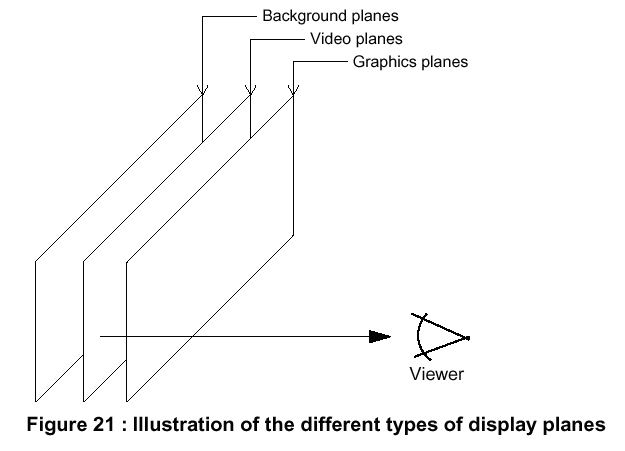
From: Digital Video Broadcasting (DVB); Multimedia Home Platform (MHP), Specification 1.1 (ETSI 2000).
A set of coordinates is defined for graphics used in Java programmes. This is in addition to the coordinate spaces defined for CSS, used in XHTML.
Internet access clients
MHP supports referencing DVB services & content on the web. That is clicking on a link to DVB content will launch the DVB service (such as video). However, there appears to be an attempt to keep MHP self contained and not blended with web content.
There is no requirement for MHP terminals to support internet streaming media content, but the Java Media Framework (Java Media Player Specification) can be used to provide this.
MHP devices are required to support the "mailto" URL, allowing the user to send e-mail using an SMTP client or Web-based mail service. Protocols for receiving email are not specified, but could be assumed to use POP or web based email. Support of Usenet news via NNTP or a Web-based client is included in the Internet Access profile. E-mail is not necessarily required by all users, but Usenet news can be efficiently distributed by broadcast.
Compatibility with the Internet
MHP is built from the same components as the Internet. Making an MHP device that also provides Internet access should be feasible. Web sites can be launched from MHP services and MHP from the web. However, MHP is designed to provide Internet-like TV broadcast services, in much the same way WAP was designed to provide web-like services on a mobile telephone. The result is a closed business model very different from the Internet. WAP developers envisaged that WAP content providers would provide a rich range of services for which consumer would be prepared to pay. However, WAP could not compete with the Internet's open and free ethos.
An MHP device could be produced from a personal computer with a digital broadcast card and software added. Such a device could support MHP and have good Internet compatibility. However, expanding existing DVB set-top boxes to handle MHP will prove a challenge, even without allowing for Internet access as well. Entry level set-top boxes do not contain a hard disk and so can have only limited software. Digital video recorders, such as the TiVo, may provide the early platform for MHP.
Opportunities for convergence of content
MHP provides the opportunity for thinking about the creation of hybrid works that are part web site and part live TV. This can go beyond the creation of a web site based on a TV show. Content could be written for delivery to both an interactive and broadcast audience. Some pointers to the required techniques could come from the production of educational material and from the design of computer games.
A parallel can be drawn with the Wireless Access Protocol (WAP). With the support of the telecommunications industry it was envisaged that WAP would provide an Internet-like standard on mobile devices and support for m-commerce. However, WAP required implementation of a large and complex set of standards that, while based on existing Internet standards, were not upward compatible. In addition there was an attempt to isolate users of WAP from the real Internet and its free content. WAP has failed as a product and the rival i-mode appears likely to succeed.
MHP is sufficiently different to the Internet that convergence of content may not be possible. MHP has not adopted SMIL, the web's approach to multimedia. It could be argued that SMIL has not been widely supported and a standard backed by the TV industry will be more successful. However, experience with Internet standards has shown this approach does not necessarily work.
It is possible that simple alternatives to MHP may emerge, in the same way i-mode emerged from the shadow of WAP. As an example it would be feasible to carry multimedia content using the existing Teletext data channel of analog TV. This would provide many of the features of MHP, but at a lower cost and while maintaining compatibility with existing TV standards. Creating an Electronic Programme Guide format that could be used by MHP should be possible, in particular, web and Teletext services.
Conclusion
In theory the use of Internet and web standards for MHP should provide opportunities for convergence. Using common tools to produce content that can be used on the Internet should be possible and with broadcasting. Material used to construct a web site could be streamed for a broadcast. However, the differences in business models and production techniques may make convergence infeasible.
The major impediment to the use of MHP by Internet content producers may be the Internet-unfriendly way in which the standard has been provided. An indication of this is the distribution of MHP as one very large PDF file, with copyright restrictions on its use. Reading the standard is a cumbersome process and lowers its credibility as a guide to efficient electronic communication. This contrasts with successful Internet and web standards, available in Internet and web formats which are simple and quick to download, translate or copy.
It should not be assumed that MHP will succeed because it is based on Internet standards and has the support of the broadcasting industry. Technical standards, such as WAP, have failed, despite (or perhaps because of) high level support and detailed standards documents. MHP has the potential for success if the standard is simplified, aligned with Internet development and made freely available.
However, the technical details of MHP may prove less relevant to its success that identifying a business model for multimedia content. Do people really want extensive interactive services, or just sit back and watch TV? Integrated PC/TVs have not been marketing successes in the past. Very simple text message services have proved popular on mobile telephones whereas sophisticated WAP applications have not. This aspect of MHP needs further research.
About the Author
 Tom
Worthington is a Visiting Fellow in the Department of Computer Science at
the Australian National University. He is an independent electronic business
consultant and author of the book Net Traveller. Tom is one of the architects
of the Commonwealth Government's Internet and web strategy. The first Web
Master for the Australian Department of Defence, in 1999 he was elected a
Fellow of the Australian Computer Society for his contribution to the
development of public Internet policy. Tom is a director and past President
of the Australian Computer Society and a voting member of the Association for
Computing Machinery.
Tom
Worthington is a Visiting Fellow in the Department of Computer Science at
the Australian National University. He is an independent electronic business
consultant and author of the book Net Traveller. Tom is one of the architects
of the Commonwealth Government's Internet and web strategy. The first Web
Master for the Australian Department of Defence, in 1999 he was elected a
Fellow of the Australian Computer Society for his contribution to the
development of public Internet policy. Tom is a director and past President
of the Australian Computer Society and a voting member of the Association for
Computing Machinery.
Request for Comments
Comments, corrections and suggestions would be welcome. The author is available to give in-house presentations and consultation. Special rates are available for Australian Government agencies.
Further Information
- Books:
Slides also available
- Interactive TV is Broadcast Industry's Worst Nightmare, Media Release, 26 September 2001
- iTV Is The Broadcast Industry's Worst Nightmare, by Craig Liddell, 2 October 2001
- Interactive TV, IT issues on 666 ABC Radio, 1 October 2001
- www.mhpdev.net
- MovieLink Internet
- Website Design For Information Technology Professionals, for Australian National University students, 2001
- Author's home page
Comments and corrections to: webmaster@tomw.net.au
Copyright © Tom Worthington 2001.
